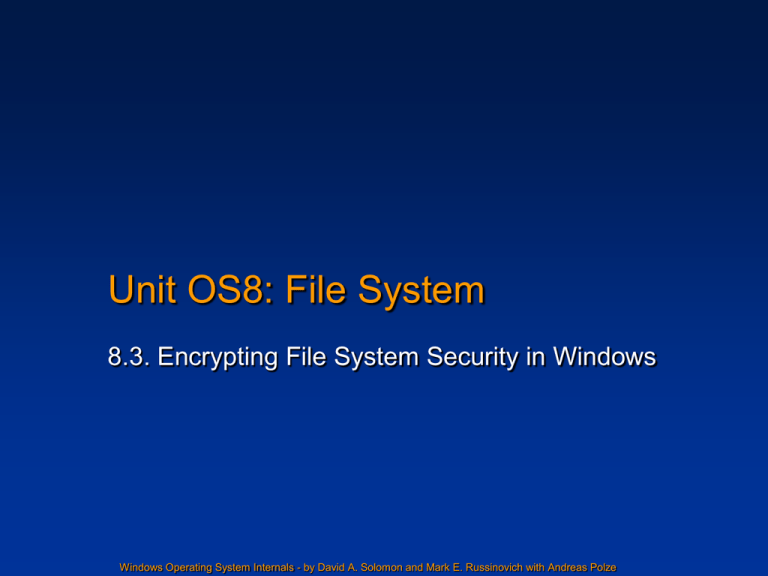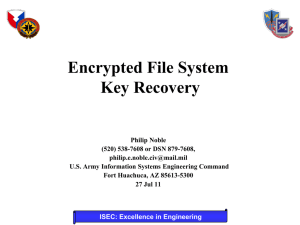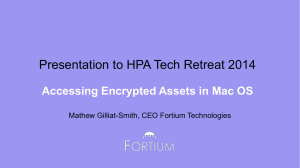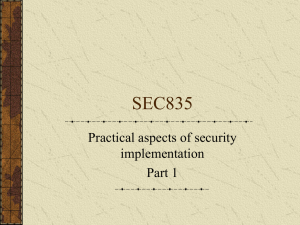8.3_NTFS-Encryption
advertisement

Unit OS8: File System 8.3. Encrypting File System Security in Windows Windows Operating System Internals - by David A. Solomon and Mark E. Russinovich with Andreas Polze Copyright Notice © 2000-2005 David A. Solomon and Mark Russinovich These materials are part of the Windows Operating System Internals Curriculum Development Kit, developed by David A. Solomon and Mark E. Russinovich with Andreas Polze Microsoft has licensed these materials from David Solomon Expert Seminars, Inc. for distribution to academic organizations solely for use in academic environments (and not for commercial use) 2 Roadmap for Section 8.3 Encrypting File System (EFS) Terminology EFS Operation Data Encryption and Decryption Windows EFS Architecture Encryption Process Details 3 Encrypting File System Security EFS relies on Windows cryptography support Transparent encryption through Windows Explorer or cipher-utility 4 EFS operation When a file is encrypted... EFS generates random File Encryption Key (FEK) to encrypt file content Stronger variant of Data Encryption Standard (U.S.: 128/intl.: 56 bit) (symmetric DESX-algorithm) to encrypt file content (fast, shared secret) File‘s FEK is stored with file and encrypted using the file creator‘s RSA public key (slow) File can be decrypted... only with the user‘s private RSA key What about lost keys? FEK can be stored in multiple encryptions... Users can share an encrypted file Can store a recovery key to allow recovery agents access to files Secure public/private key pairs are essential Stored on computer harddisk... (but soon on smartcards) 5 Basic Terminology Plaintext The stuff you want to secure, typically readable by humans (email) or computers (software, order) Ciphertext Unreadable, secure data that must be decrypted before it can be used Key You must have it to encrypt or decrypt (or do both) Cryptoanalysis Hacking it by using science Complexity Theory How hard is it and how long will it take to run a program 6 Symmetric Key Cryptography Plain-text input “The quick brown fox jumps over the lazy dog” Cipher-text Plain-text output “AxCv;5bmEseTfid3) fGsmWe#4^,sdgfMwi r3:dkJeTsY8R\s@!q3 %” “The quick brown fox jumps over the lazy dog” Encryption Decryption Same key (shared secret) 7 Symmetric Pros and Cons Weakness: Agree the key beforehand Securely pass the key to the other party Strength: Simple and really very fast (order of 1000 to 10000 faster than asymmetric mechanisms) Super-fast if done in hardware (DES) Hardware is more secure than software, so DES makes it really hard to be done in software, as a prevention 8 Public Key Cryptography Knowledge of the encryption key doesn’t give you knowledge of the decryption key Receiver of information generates a pair of keys Publish the public key in directory Then anyone can send him messages that only she can read 9 Public Key Encryption Clear-text Input “The quick brown fox jumps over the lazy dog” Cipher-text Clear-text Output “Py75c%bn&*)9|fDe^ bDFaq#xzjFr@g5=&n mdFg$5knvMd’rkveg Ms” “The quick brown fox jumps over the lazy dog” Encryption Decryption public Recipient’s public key private Different keys Recipient’s private key 10 Problem of Key Recovery What if you lose the private key? Data recovery by authorized agents Integrated key management Windows: Flexible recovery policy Enterprise, domain, or per machine Encrypted backup and restore Integrated with Windows backup Potential weakness but you can opt not to use it! 11 Data Encryption Process Launch key for nuclear missile “RedHeat” is... Data Decryption Field generation (e.g., RSA) User’s public key (in certificate) Randomlygenerated file encryption key (FEK) *#$fjda^j u539!3t t389E *&\@ 5e%32\^kd File encryption (e.g., DES) Data Recovery Field generation (e.g., RSA) RNG DDF DRF Recovery agent’s public key (in certificate) in recovery policy 12 Data Decryption Process *#$fjda^j u539!3t t389E *&\@ 5e%32\^kd File decryption (e.g., DES) File encryption key (FEK) User’s private key DDF extraction (e.g., RSA) DDF contains file encryption key (FEK) encrypted under user’s public key Launch key for nuclear missile “RedHeat” is... DDF is decrypted using the private key to get to the file encryption key (FEK) DDF 13 Data Recovery Process *#$fjda^j u539!3t t389E *&\@ 5e%32\^kd File decryption (e.g., DES) File encryption key (FEK) Recovery agent’s private key DRF extraction (e.g., RSA) DRF contains file encryption key (FEK) encrypted under recovery agent’s public key Launch key for nuclear missile “RedHeat” is... DRF is decrypted using the private key of recovery agent to get to the file encryption key (FEK) DRF 14 Windows EFS Architecture Cryptographic service providers LSAsrv LSASS Microsoft Base Cryptographic Service Provider 1.0 EFS functions User mode Kernel mode ... LPC KSecDD Uses impersonation to de/encrypt files in the appropriate user account Application EFS callouts EFS Encrypted file access NTFS 15 EFS Components Local Security Authority Subsystem LSASS (\Winnt\System32\Lsass.exe) manages logon sessions EFS obtains FEKs from LSASS KSecDD device driver implements comm. with LSASS LSAsrv listens for LPC comm. Passes requests to EFS functions Uses functions in MS CryptoAPI (CAPI) to decrypt FEK for EFS Crypto API ... is implemented by Cryptographic Service Provider (CSP) DLLs Details of encryption/key protection are abstracted away Windows XP and Server 2003 have EFS support merged into NTFS driver Windows 2000 had separate EFS driver - tightly connected with NTFS 16 Format of EFS information and key entries for a file EFS information Version Header Checksum Number of DDF key entries Data decryption field DDF key entry 1 DDF key entry 2 Key entry User SID (S-1-5-21-...) Container name (ee341-2144-55ba...) Provider Name Data recovery field Number of DRF key entries Key ring (users sharing a file) DRF key entry 1 Describes the storage position of the user‘s key (MS Base Cryptographic Provider 1.0) EFS certificate hash (cb3e4e...) Encrypted FEK (03fe4f3c...) 17 Encrypted Data Recovery Agents group policy Use Group Policy MMC snap-in to configure recovery agents (...list may be empty) 18 Flow of EFS Application 1 Application writes data to an encrypted file 2 NTFS places data in EFS driver 4 NTFS asks EFS driver to encrypt file contents headed to disk Note: EFS driver has been merged into NTFS on Windows XP and later NTFS file system driver file system cache Cache manager 3 Cache manager lazy writes data to disk via NTFS 5 NTFS writes encrypted file contents to disk Volume 19 Encryption Process Details 1. User profile is loaded if necessary 2. A log file Efsx.log is created • In system volume info dir; x is unique number 3. Base Cryptographic Provider 1.0 generates random 128-bit FEK 4. User EFS private/public key pair is generated or obtained • HKEY_CURRENT_USER\Software\Microsoft\Windows NT\CurrentVersion \EFS\CurrentKeys\CertificateHash identifies the user‘s key pairs 5. A DDF key ring is created for the file with an entry for the user • Entry contains copy of FEK encrypted with user‘s public key 6. A DRF key ring is created for the file • Has an entry for each recovery agent on the system • Entries contain copies of FEK encrypted with agents‘ public keys 20 Encryption Process Details (contd.) 7. A backup file is created (Efs0.tmp) • Same directory as original file 8. DDF and DRF rings are added to a header • EFS attributes - $LOGGED_UTILITY_STREAM 9. Backup file is marked encrypted, original file is copied to backup 10. Original file‘s contents are destroyed • • Backup is copied to original This results in encrypting the file contents 11. The backup file is deleted 12. The log file is deleted 13. The user profile is unloaded (if it was loaded in step 1) In case of system crash, either original file or backup contain valid copy of the file content. 21 Backing Up Encrypted Files Data is never available in unencrypted form Except to applications that access file via encryption facility EFS provides a facility for backup programs: New EFS API: OpenEncryptedFileRaw(), ReadEncryptedFileRaw(), WriteEncryptedFileRaw(), CloseEncryptedFileRaw() Implemented in Advapi32.dll, use LPC to invoke function in LSAsrv LSAsrv calls EfsReadFileRaw() to obtain file‘s EFS attribute and the encrypted contents from NTFS driver Similarly, EfsWriteFileRaw() is invoked to restore file‘s contents 22 Further Reading Mark E. Russinovich and David A. Solomon, Microsoft Windows Internals, 4th Edition, Microsoft Press, 2004. Encrypting File System Security (from pp. 775) Encrypting a File for the first time (from pp. 778) The Decryption Process (from pp. 783) Applied Cryptography, B. Schneier, John Wiley & Sons, ISBN 0-471-12845-7 Handbook of Applied Cryptography, A.J. Menezes, CRC Press, ISBN 0-8493-8523-7 23 Source Code References Windows Research Kernel sources do not include NTFS A raw file system driver is included in \base\ntos\raw Also see \base\ntos\fstrl (File System Run-Time Library) 24






